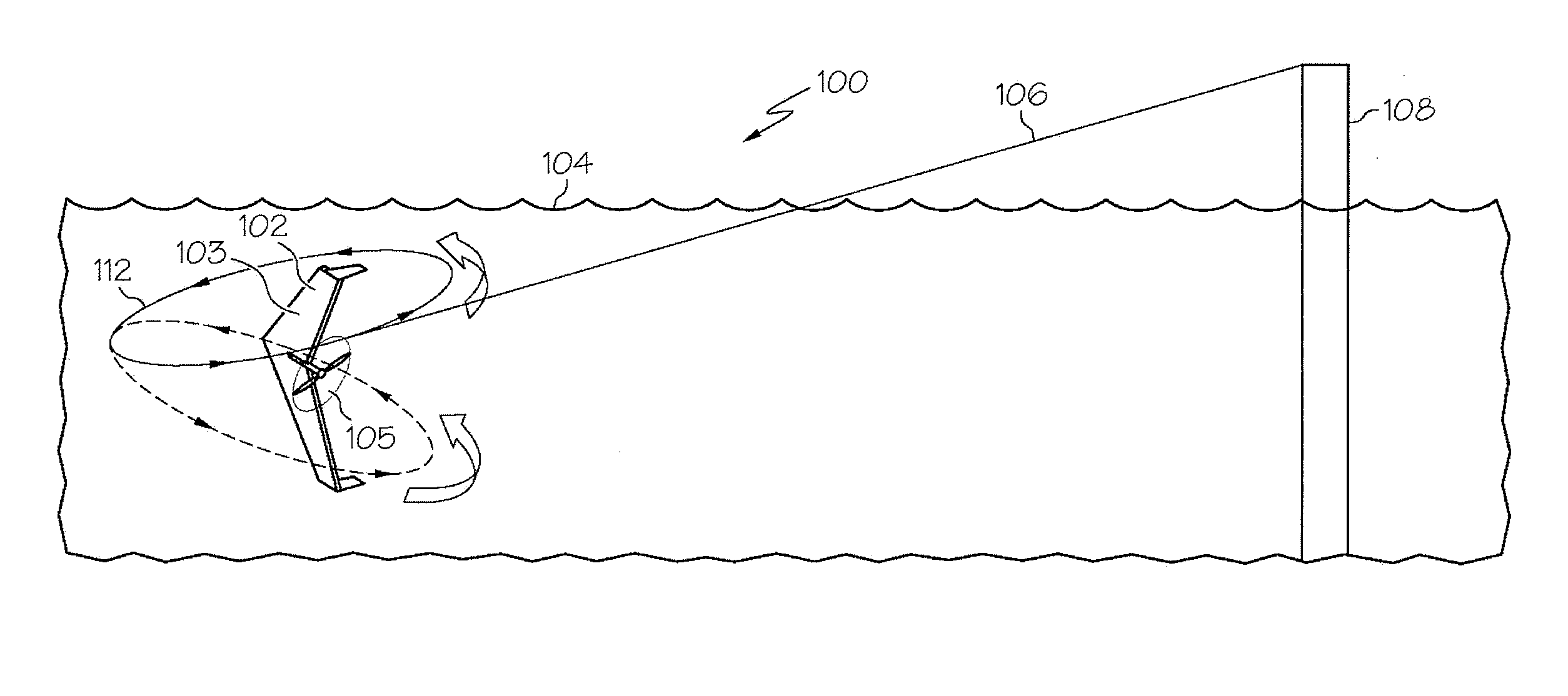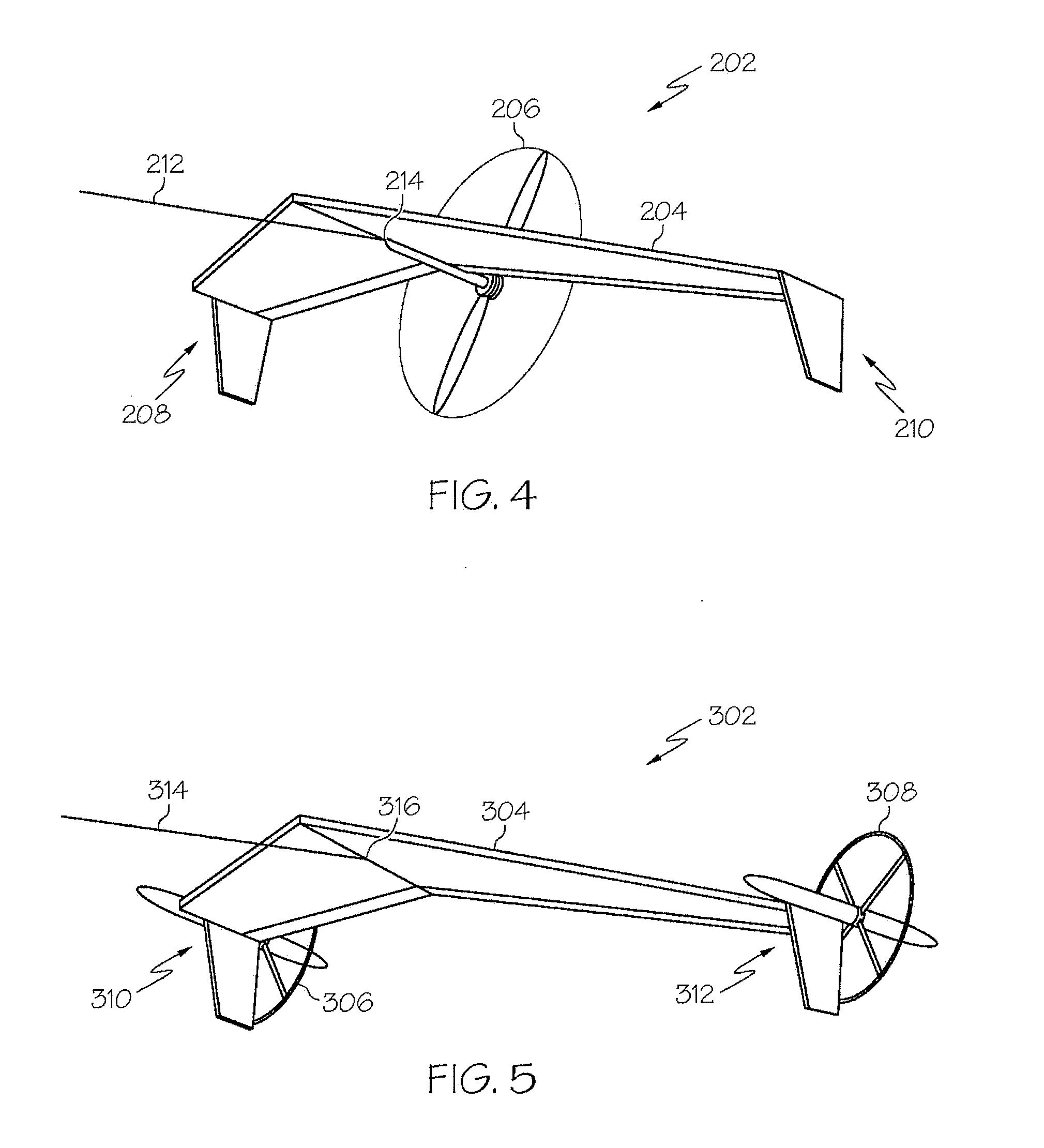Tethered aquatic device with water power turbine
- Summary
- Abstract
- Description
- Claims
- Application Information
AI Technical Summary
Benefits of technology
Problems solved by technology
Method used
Image
Examples
first embodiment
[0035]FIG. 4 illustrates a TAD 202, including a hydrofoil 204 and one trailing (relative to the direction of travel) water power turbine 206. The hydrofoil 204 is designed including a first wing tip 208 and a second wing tip 210. The TAD 202 is tethered to an anchorage or mooring point, (base station 108 of FIG. 1) via a tether 212 attached to a tether attachment point 214 located on the hydrofoil 204.
[0036]In general, trailing water power turbines are preferred to leading water power turbines for several reasons. First, trailing turbines will have a minimal effect on the flow of water over the top and bottom surfaces of the hydrofoil and a negligible effect on the lift / drag of the TAD. A leading turbine, or turbines, will extract energy from the water that passes through the rotor thus decreasing the velocity of the water flowing over the hydrofoil and reducing the lift. Second, trailing turbines will increase overall stability since the drag created by them is behind the TAD. Drag...
second embodiment
[0037]FIG. 5 illustrates a TAD 302 including a hydrofoil 304 having two trailing water power turbines 306 and 308. The hydrofoil 304 is designed including a first wing tip 310 and a second wing tip 312. A first trailing water power turbine 306 is located at the first wing tip 310 and a second trailing water power turbine 308 is located at the second wing tip 312. A tether 314 is attached to a tether attachment point 316 located on the underside of the hydrofoil 304. This configuration has the benefit of not needing winglets to reduce vortices drag. Differential drag between multiple turbines can also a degree of control authority.
third embodiment
[0038]FIG. 6 illustrates a TAD 402 including a hydrofoil 404 having two trailing water power turbines 406 and 408 and a forward facing or leading water power turbine 414. The hydrofoil 404 is designed including a first wing tip 410 and a second wing tip 412. A first trailing water power turbine 406 is located at the first wing tip 410 and a second trailing water power turbine 408 is located at the second wing tip 412. The forward facing water power turbine 414 is located at the center of the hydrofoil 404 to provide a balancing weight to the front of the hydrofoil 404. This balancing weight increases static stability as well as pitch control. A tether 416 splits into two separate tether portions, wherein a first tether portion 418 attaches at a first attachment point 420 located near the first wing tip 410 and a second tether portion 422 attaches at a second attachment point 424 located near the second wing tip 412.
PUM
 Login to View More
Login to View More Abstract
Description
Claims
Application Information
 Login to View More
Login to View More - R&D
- Intellectual Property
- Life Sciences
- Materials
- Tech Scout
- Unparalleled Data Quality
- Higher Quality Content
- 60% Fewer Hallucinations
Browse by: Latest US Patents, China's latest patents, Technical Efficacy Thesaurus, Application Domain, Technology Topic, Popular Technical Reports.
© 2025 PatSnap. All rights reserved.Legal|Privacy policy|Modern Slavery Act Transparency Statement|Sitemap|About US| Contact US: help@patsnap.com



